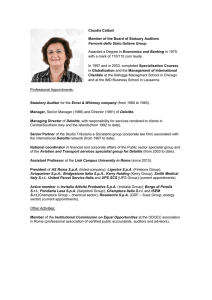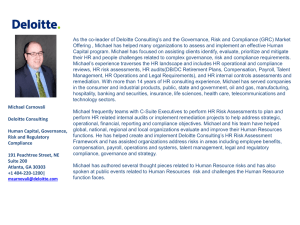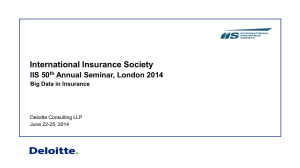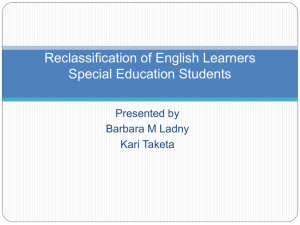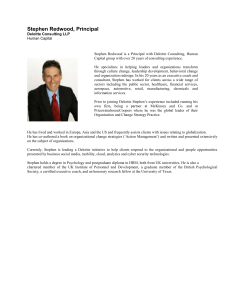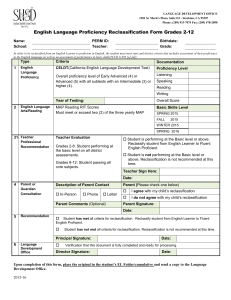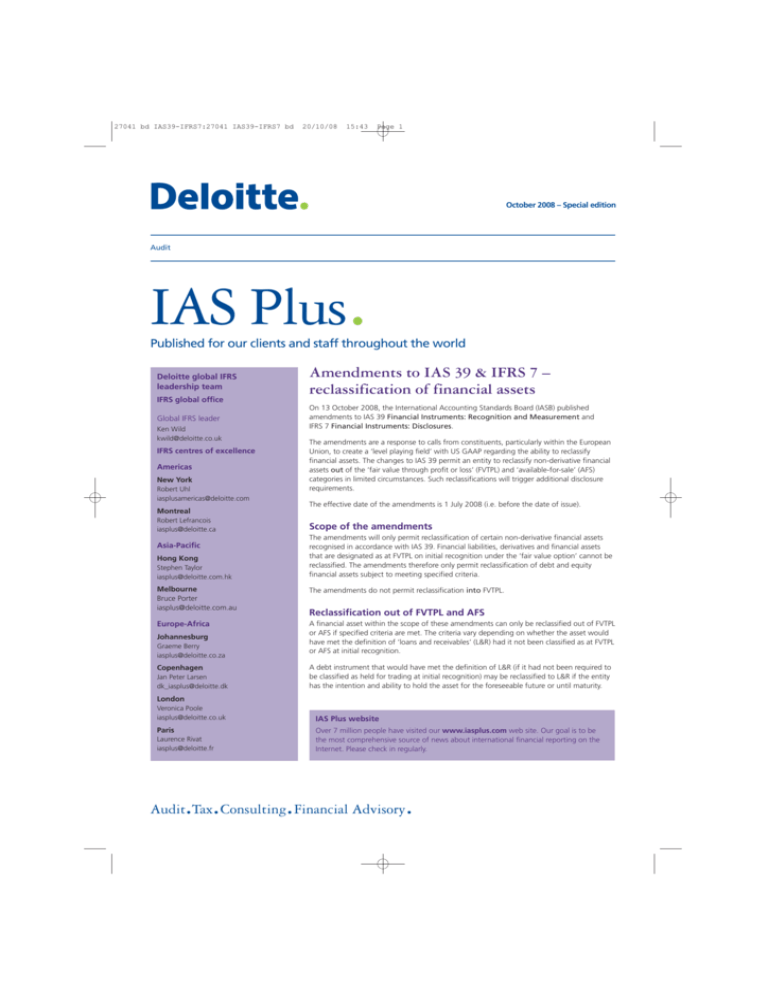
27041 bd IAS39-IFRS7:27041 IAS39-IFRS7 bd
20/10/08
15:43
Page 1
October 2008 – Special edition
Audit
IAS Plus.
Published for our clients and staff throughout the world
Amendments to IAS 39 & IFRS 7 –
reclassification of financial assets
Deloitte global IFRS
leadership team
IFRS global office
On 13 October 2008, the International Accounting Standards Board (IASB) published
amendments to IAS 39 Financial Instruments: Recognition and Measurement and
IFRS 7 Financial Instruments: Disclosures.
Global IFRS leader
Ken Wild
kwild@deloitte.co.uk
The amendments are a response to calls from constituents, particularly within the European
Union, to create a ‘level playing field’ with US GAAP regarding the ability to reclassify
financial assets. The changes to IAS 39 permit an entity to reclassify non-derivative financial
assets out of the ‘fair value through profit or loss’ (FVTPL) and ‘available-for-sale’ (AFS)
categories in limited circumstances. Such reclassifications will trigger additional disclosure
requirements.
IFRS centres of excellence
Americas
New York
Robert Uhl
iasplusamericas@deloitte.com
The effective date of the amendments is 1 July 2008 (i.e. before the date of issue).
Montreal
Robert Lefrancois
iasplus@deloitte.ca
Scope of the amendments
The amendments will only permit reclassification of certain non-derivative financial assets
recognised in accordance with IAS 39. Financial liabilities, derivatives and financial assets
that are designated as at FVTPL on initial recognition under the ‘fair value option’ cannot be
reclassified. The amendments therefore only permit reclassification of debt and equity
financial assets subject to meeting specified criteria.
Asia-Pacific
Hong Kong
Stephen Taylor
iasplus@deloitte.com.hk
Melbourne
Bruce Porter
iasplus@deloitte.com.au
The amendments do not permit reclassification into FVTPL.
Europe-Africa
A financial asset within the scope of these amendments can only be reclassified out of FVTPL
or AFS if specified criteria are met. The criteria vary depending on whether the asset would
have met the definition of ‘loans and receivables’ (L&R) had it not been classified as at FVTPL
or AFS at initial recognition.
Reclassification out of FVTPL and AFS
Johannesburg
Graeme Berry
iasplus@deloitte.co.za
A debt instrument that would have met the definition of L&R (if it had not been required to
be classified as held for trading at initial recognition) may be reclassified to L&R if the entity
has the intention and ability to hold the asset for the foreseeable future or until maturity.
Copenhagen
Jan Peter Larsen
dk_iasplus@deloitte.dk
London
Veronica Poole
iasplus@deloitte.co.uk
IAS Plus website
Paris
Over 7 million people have visited our www.iasplus.com web site. Our goal is to be
the most comprehensive source of news about international financial reporting on the
Internet. Please check in regularly.
Laurence Rivat
iasplus@deloitte.fr
. .
.
.
Audit Tax Consulting Financial Advisory
27041 bd IAS39-IFRS7:27041 IAS39-IFRS7 bd
20/10/08
15:43
Page 2
IAS Plus – October 2008 – Special edition
A debt instrument classified as AFS that would have met the definition of L&R (if it had not
been designated as AFS) may be reclassified to the L&R category if the entity has the
intention and ability to hold the financial asset for the foreseeable future or until maturity.
Any other debt instrument, or any equity instrument, may be reclassified from FVTPL to AFS,
or from FVTPL to HTM (in the case of debt instruments only), if the financial asset is no
longer held for the purpose of selling in the near term – but only in ‘rare’ circumstances.
In its press release the IASB acknowledged that market conditions in the third quarter of
2008 are a possible example of a ‘rare’ circumstance.
It should be noted that the amendments do not refer to the reclassification of AFS debt
instruments to HTM because IAS 39 already permitted such reclassifications (see IAS 39.54).
These reclassifications are not within the scope of the current amendments, and therefore
they do not trigger the additional disclosures required by IFRS 7.12A referred to below.
Measurement at the reclassification date
All reclassifications must be made at the fair value of the financial asset at the date of
reclassification. Any previously recognised gains or losses cannot be reversed. The fair value
at the date of reclassification becomes the new cost or amortised cost of the financial asset,
as applicable.
Measurement after the reclassification date
The existing requirements in IAS 39 for measuring financial assets at cost or amortised cost
apply after the reclassification date (with one exception – see below). Therefore, for financial
assets measured at amortised cost, a new effective interest rate will be determined at the
date of reclassification. In the case of reclassifications of a fixed rate debt instrument to L&R
and HTM, this effective interest rate will be used as the discount rate for future impairment
calculations.
For reclassifications out of AFS, IAS 39.54 requires the amounts previously recognised in
other comprehensive income (OCI) to be reclassified to profit or loss either through the
effective interest rate (if the instrument has a maturity) or at disposal (if the instrument has
no maturity – i.e. it is perpetual). Amounts deferred in equity may also need to be
reclassified to profit or loss if there is an impairment.
The one exception to the existing measurement requirements is for reclassified debt
instruments. If, after reclassification, an entity increases its estimate of recoverability of
future cash flows, the carrying amount is not adjusted upwards as is currently required by
IAS 39.AG8 for changes in estimates of cash flows. Instead, a new effective interest rate is
determined and is applied from that date forward. Hence, the increase in the recoverability
of cash flows is recognised over the expected life of the financial asset.
Disclosures
To make transparent to users any reclassifications under the new requirements, IFRS 7 is also
amended. Although the requirements for reclassifications in accordance with IAS 39.51-54
remain unchanged (IFRS 7.12), the following additional disclosures are required for
reclassifications within the scope of the current amendments (new paragraph IFRS 7.12A):
2
•
the amount reclassified into and out of each category;
•
for each reporting period until derecognition, the carrying amounts and fair values of all
financial assets reclassified in the current or previous reporting periods;
•
if the financial asset has been reclassified based on the ‘rare circumstances’ exception,
details of those circumstances – including the factors that indicated that the situation
was rare;
•
the fair value gain or loss recognised in profit or loss or OCI for the reporting period in
which reclassification occurs and in the previous period;
•
in the period of reclassification and in subsequent periods until the financial asset is
derecognised, the gain or loss that would have been recognised in profit or loss or OCI
had the financial asset not been reclassified, and the actual gain, loss, income and
expense recognised in profit or loss; and
•
the effective interest rate and estimated cash flows the entity expects to recover as at
the date of reclassification of the financial asset.
27041 bd IAS39-IFRS7:27041 IAS39-IFRS7 bd
20/10/08
15:43
Page 3
IAS Plus – October 2008 – Special edition
Effective date and transition
These amendments are effective from 1 July 2008. Entities are not permitted to reclassify
financial assets in accordance with the amendments before 1 July 2008. Any reclassification
of a financial asset made in periods beginning on or after 1 November 2008 will take effect
only from the date when the reclassification is made. Any reclassification of a financial asset
in accordance with the amendments should not be applied retrospectively to reporting
periods ended before the effective date.
For more information on Deloitte Touche Tohmatsu, please access our website at www.deloitte.com
Deloitte provides audit, tax, consulting, and financial advisory services to public and private clients spanning multiple
industries. With a globally connected network of member firms in 140 countries, Deloitte brings world-class capabilities
and deep local expertise to help clients succeed wherever they operate. Deloitte’s 150,000 professionals are committed
to becoming the standard of excellence.
Deloitte’s professionals are unified by a collaborative culture that fosters integrity, outstanding value to markets and
clients, commitment to each other, and strength from cultural diversity. They enjoy an environment of continuous
learning, challenging experiences, and enriching career opportunities. Deloitte’s professionals are dedicated to
strengthening corporate responsibility, building public trust, and making a positive impact in their communities.
Deloitte refers to one or more of Deloitte Touche Tohmatsu, a Swiss Verein, and its network of member firms, each of
which is a legally separate and independent entity. Please see www.deloitte.com/about for a detailed description of the
legal structure of Deloitte Touche Tohmatsu and its member firms.
This publication contains general information only and is not intended to be comprehensive nor to provide specific
accounting, business, financial, investment, legal, tax or other professional advice or services. This publication is not
a substitute for such professional advice or services, and it should not be acted on or relied upon or used as a basis for
any decision or action that may affect you or your business. Before making any decision or taking any action that may
affect you or your business, you should consult a qualified professional advisor.
Whilst every effort has been made to ensure the accuracy of the information contained in this publication, this cannot
be guaranteed, and neither Deloitte Touche Tohmatsu nor any related entity shall have any liability to any person or
entity that relies on the information contained in this publication. Any such reliance is solely at the user’s risk.
© Deloitte Touche Tohmatsu 2008. All rights reserved.
Designed and produced by The Creative Studio at Deloitte, London. 27041

